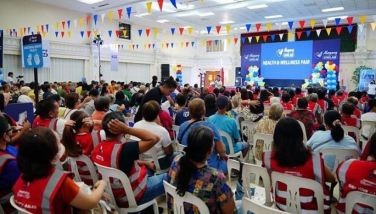Use Antarctica solution to ease Spratly tension - GOTCHA by Jarius Bondoc
April 7, 2001 | 12:00am
Imagine this scenario: China dispatches an armada to the Kalayaan Group (Spratlys) with an ultimatum for RP to vacate seven occupied isles. Brave Filipino air and seamen, though outnumbered and outgunned, brace for battle. To dramatize its seriousness, the enemy shells nearby isles held by Vietnam. RP gets the message. Civilians flee to Palawan. Manila quietly orders humiliated Filipino troops to pack up. China raises its flag on Pag-asa Island, center of Palawan’s Kalayaan township. From there, it sends another ultimatum for RP to steer clear of islands near Palawan and Luzon: Mischief Reef, Sabina Shoal, Scarborough Shoal.
Filipino saber-rattlers will want to ignore the scenario. Still, it’s likely to unfold in November 2004, the UN deadline for countries with territorial sea disputes to submit legal – that is, geologic – evidence of their claims. Seven years since the UN Convention on Law of the Sea set the deadline in 1994, RP has yet to start bathymetric surveys of its western continental shelf. China already has conducted such mapping of Kalayaan’s undersea topography from the water surface, but refuses to share its findings with RP. Germany, too, had surveyed the area thrice in the ‘80s. Some of its data shown to Filipino scientists revealed that the Reed Bank, a vast underwater plateau in the South China Sea on which the Kalayaan Group perches, is part of RP’s continental shelf. Beyond it are deeper waters that then rise to another continental shelf, that of China and mainland Asia.
If produced by RP and verified by international experts, such fossil evidence will prove RP’s claim and reverse the dreaded 2004 scenario. But time’s running out. The Estrada administration last year stopped three modern RP mapping ships from even crossing the "trip wire" at 116 degrees longitude where they would likely encounter Chinese ships. The order is still in force, and thus limits the ships to surveying waters only a few dozen miles off Palawan. China has noticed the virtual surrender of Kalayaan far to the west, and thus is encroaching on the nearby isles of Sabina, Mischief, Scarborough – with the aim of controlling Palawan’s northern waters where Malampaya oil well is set to pump fuel to Manila also by 2004.
Sure to not beat the UNCLOS deadline and with the Air Force and Navy in disrepair, Manila has taken another tack. It is offering to China and other Kalayaan claimants – Vietnam, Malaysia, Taiwan and Brunei – joint use of the area’s oil, mineral and aquatic resources. Following the proposal of John W. McManus in the Journal of Human Environment, RP is asking for ASEAN support to convert Kalayaan into a marine park. The area crosses over 300 nautical miles; has 26 islands, seven exposed rocks, and dozens of reefs and sandbars, 40 of which are occupied by troops from the claimant-countries. Like Australia’s Great Barrier Reef, it is host to one of the world’s most diverse undersea flora and fauna. Once converted into a park, it could, like Australia’s reef, rake in $1.5 billion a year from tourism alone. Part of RP’s joint-use plan is to share in the cost and fruit of exploiting the oil and aquatic resources – under strict UN environmental rules. Given the vast oil resources underneath Kalayaan’s limestone bed, that would account for billions of dollars more for the claimants. The small Malampaya alone would yield $2 billion a year for RP.
The joint-use offer has precedents in history. In Antarctica, a treaty was signed in 1957 among many claimant-countries to prevent unbridled exploitation, advance scientific research and, most of all, prevent war. A hundred years before that, independent explorers braved the ice caps and harsh storms in a sometimes friendly, sometimes bitter competition to reach the South Pole. Their countries followed soon afterwards to declare claims or simply put up military barracks. After the First World War, US, Britain, France, Germany, Norway, New Zealand, Australia, Argentina and Chile divided Antarctica among themselves like pie slices. But the slices overlapped, and military skirmishes threatened to ignite another war. The powers saw the futility of it all, and decided to suspend all their claims in favor of joint use. Although the treaty called for review every 30 years, it called for cooperation in and sharing of scientific research, ban on nuclear weapons tests and, most of all, peaceful use of the continent.
Kalayaan’s claimants can also fall back on another applicable treaty. The Torres Straits Treaty between Australia and Papua New Guinea aims to protect the waters, isles and reefs between them from over- exploitation. Subsequently, the two sides designated marine reserves devoted only for scientific study and open-sea fish nurseries.
If ASEAN – RP, Malaysia, Brunei, Vietnam, Indonesia, Thailand, Singapore, Laos, Cambodia – can convince giant China to go for joint use, tensions in Kalayaan might greatly ease. Or it may not. In the wake of another arrest of a dozen Chinese poachers off Scarborough Shoal two weeks ago, China is warming up to the idea of a fishing ban in the area. While China sees a ban as ecologically necessary to replenish fish stocks – thus, only three months a year – RP views it as a permanent way to avoid anymore military clashes in the isle just 180 miles off Subic. The difference in viewpoint does not augur well for a longer-term standoff.
And Scarborough is not in Kalayaan but in Zambales. Still, joint use is the best option, for now, if only to conserve ASEAN’s fish resources. East Asia’s tuna spawn in Tubbataha Reef between Palawan, Mindanao and Negros. The fish swim north of Palawan to the Kalayaan isles, then south and east to the Mindanao and Celebes Sea, where they are caught fully-grown. Continued Chinese overfishing of half-grown tuna in Kalayaan would deplete adults from spawning in Tubbataha the next season. Thus, the urgency of getting China to sign up for joint use.
Yet joint use shouldn’t end RP’s claim to Kalayaan. Dr. Jose Antonio Socrates, Palawan provincial health officer and world-renowned geologist, warns against RP’s falling for an illusory happy ending. Joint use can prevent armed clashes, but not settle the overlapping claims. It is but the first move in a long chess game. Socrates would rather that Malacañang lifts the no-cross order on the trip wire 116 degrees longitude, and go on with the mapping of Kalayaan Group. More so since the German and other scientific studies already show the islands to be resting on RP’s continental shelf, and thus can prove legal, geologic ownership under UNCLOS.
One such study is that of Puerto Princesa’s famed underground river tourist attraction in the center of elongated Palawan. The river cuts through limestone formations of Mount St. Paul. The limestone is "only" 50 million years old, yet extends all the way to the Reed Bank under Kalayaan isles. A few miles north to El Nido are totally different limestones – 250 million years old and holding under it the oil reserves of Malampaya well. The Puerto Princesa limestone is so unlike those found in China, yet El Nido’s is as old and as similar to mainland Asia’s. This, Socrates avers, is proof of the birth of Palawan and the rest of the Philippine archipelago on its own continental shelf. It also disproves China’s claim to Kalayaan, much more to Mischief, Sabina and the Scarborough closer to Palawan and Luzon.
Fifty million years ago, the Philippine archipelago still didn’t exist. But there already was a Philippine plate under the sea, lighter and thus rising higher than the Pacific plate on the east. Asia and Europe already existed as one continent that geologists now call Laurasia, which was resting on its own plate to the east. Another giant continent to the south, Gondwanaland, split into three: Antarctica drifted downwards, Australia upwards to hit the Celebes plate, and India still farther upwards to hit Laurasia. The collision of the Indian subcontinent with Laurasia’s equally dense plates forced their shores upward to form the Himalayas. The impact broke Laurasia on its fault lines, sending fragments floating off to sea. One such fragment – from what is now China – floated eastward on its plate towards the Pacific, and hit the Philippine plate. Since that fragment was heavier, it landed below the Philippine plate and pushed the latter eastward and upward. Thus was born the Philippine archipelago. Meanwhile, undersea plate tremors from the collision also pushed up a portion of the Philippine plate farther south, forming Palawan’s lower half. The fragment from the China part of Laurasia, landed and stopped north of this ridge to form Palawan’s Northern Block. This explains why RP’s continental shelf abruptly drops to the Pacific a few hundred miles east, but extends far to the west for hundreds of miles before dropping into the deeper waters of South China Sea.
All this happened well before humans began populating China. Well before Peking Man (homo erectus) began picking fruits from trees. Certainly well before any of China’s claim today of fishing rights over the Kalayaan isles. Yet such evidence is what UNCLOS is waiting for.
You can e-mail comments to [email protected]
Filipino saber-rattlers will want to ignore the scenario. Still, it’s likely to unfold in November 2004, the UN deadline for countries with territorial sea disputes to submit legal – that is, geologic – evidence of their claims. Seven years since the UN Convention on Law of the Sea set the deadline in 1994, RP has yet to start bathymetric surveys of its western continental shelf. China already has conducted such mapping of Kalayaan’s undersea topography from the water surface, but refuses to share its findings with RP. Germany, too, had surveyed the area thrice in the ‘80s. Some of its data shown to Filipino scientists revealed that the Reed Bank, a vast underwater plateau in the South China Sea on which the Kalayaan Group perches, is part of RP’s continental shelf. Beyond it are deeper waters that then rise to another continental shelf, that of China and mainland Asia.
If produced by RP and verified by international experts, such fossil evidence will prove RP’s claim and reverse the dreaded 2004 scenario. But time’s running out. The Estrada administration last year stopped three modern RP mapping ships from even crossing the "trip wire" at 116 degrees longitude where they would likely encounter Chinese ships. The order is still in force, and thus limits the ships to surveying waters only a few dozen miles off Palawan. China has noticed the virtual surrender of Kalayaan far to the west, and thus is encroaching on the nearby isles of Sabina, Mischief, Scarborough – with the aim of controlling Palawan’s northern waters where Malampaya oil well is set to pump fuel to Manila also by 2004.
Sure to not beat the UNCLOS deadline and with the Air Force and Navy in disrepair, Manila has taken another tack. It is offering to China and other Kalayaan claimants – Vietnam, Malaysia, Taiwan and Brunei – joint use of the area’s oil, mineral and aquatic resources. Following the proposal of John W. McManus in the Journal of Human Environment, RP is asking for ASEAN support to convert Kalayaan into a marine park. The area crosses over 300 nautical miles; has 26 islands, seven exposed rocks, and dozens of reefs and sandbars, 40 of which are occupied by troops from the claimant-countries. Like Australia’s Great Barrier Reef, it is host to one of the world’s most diverse undersea flora and fauna. Once converted into a park, it could, like Australia’s reef, rake in $1.5 billion a year from tourism alone. Part of RP’s joint-use plan is to share in the cost and fruit of exploiting the oil and aquatic resources – under strict UN environmental rules. Given the vast oil resources underneath Kalayaan’s limestone bed, that would account for billions of dollars more for the claimants. The small Malampaya alone would yield $2 billion a year for RP.
The joint-use offer has precedents in history. In Antarctica, a treaty was signed in 1957 among many claimant-countries to prevent unbridled exploitation, advance scientific research and, most of all, prevent war. A hundred years before that, independent explorers braved the ice caps and harsh storms in a sometimes friendly, sometimes bitter competition to reach the South Pole. Their countries followed soon afterwards to declare claims or simply put up military barracks. After the First World War, US, Britain, France, Germany, Norway, New Zealand, Australia, Argentina and Chile divided Antarctica among themselves like pie slices. But the slices overlapped, and military skirmishes threatened to ignite another war. The powers saw the futility of it all, and decided to suspend all their claims in favor of joint use. Although the treaty called for review every 30 years, it called for cooperation in and sharing of scientific research, ban on nuclear weapons tests and, most of all, peaceful use of the continent.
Kalayaan’s claimants can also fall back on another applicable treaty. The Torres Straits Treaty between Australia and Papua New Guinea aims to protect the waters, isles and reefs between them from over- exploitation. Subsequently, the two sides designated marine reserves devoted only for scientific study and open-sea fish nurseries.
If ASEAN – RP, Malaysia, Brunei, Vietnam, Indonesia, Thailand, Singapore, Laos, Cambodia – can convince giant China to go for joint use, tensions in Kalayaan might greatly ease. Or it may not. In the wake of another arrest of a dozen Chinese poachers off Scarborough Shoal two weeks ago, China is warming up to the idea of a fishing ban in the area. While China sees a ban as ecologically necessary to replenish fish stocks – thus, only three months a year – RP views it as a permanent way to avoid anymore military clashes in the isle just 180 miles off Subic. The difference in viewpoint does not augur well for a longer-term standoff.
And Scarborough is not in Kalayaan but in Zambales. Still, joint use is the best option, for now, if only to conserve ASEAN’s fish resources. East Asia’s tuna spawn in Tubbataha Reef between Palawan, Mindanao and Negros. The fish swim north of Palawan to the Kalayaan isles, then south and east to the Mindanao and Celebes Sea, where they are caught fully-grown. Continued Chinese overfishing of half-grown tuna in Kalayaan would deplete adults from spawning in Tubbataha the next season. Thus, the urgency of getting China to sign up for joint use.
Yet joint use shouldn’t end RP’s claim to Kalayaan. Dr. Jose Antonio Socrates, Palawan provincial health officer and world-renowned geologist, warns against RP’s falling for an illusory happy ending. Joint use can prevent armed clashes, but not settle the overlapping claims. It is but the first move in a long chess game. Socrates would rather that Malacañang lifts the no-cross order on the trip wire 116 degrees longitude, and go on with the mapping of Kalayaan Group. More so since the German and other scientific studies already show the islands to be resting on RP’s continental shelf, and thus can prove legal, geologic ownership under UNCLOS.
One such study is that of Puerto Princesa’s famed underground river tourist attraction in the center of elongated Palawan. The river cuts through limestone formations of Mount St. Paul. The limestone is "only" 50 million years old, yet extends all the way to the Reed Bank under Kalayaan isles. A few miles north to El Nido are totally different limestones – 250 million years old and holding under it the oil reserves of Malampaya well. The Puerto Princesa limestone is so unlike those found in China, yet El Nido’s is as old and as similar to mainland Asia’s. This, Socrates avers, is proof of the birth of Palawan and the rest of the Philippine archipelago on its own continental shelf. It also disproves China’s claim to Kalayaan, much more to Mischief, Sabina and the Scarborough closer to Palawan and Luzon.
Fifty million years ago, the Philippine archipelago still didn’t exist. But there already was a Philippine plate under the sea, lighter and thus rising higher than the Pacific plate on the east. Asia and Europe already existed as one continent that geologists now call Laurasia, which was resting on its own plate to the east. Another giant continent to the south, Gondwanaland, split into three: Antarctica drifted downwards, Australia upwards to hit the Celebes plate, and India still farther upwards to hit Laurasia. The collision of the Indian subcontinent with Laurasia’s equally dense plates forced their shores upward to form the Himalayas. The impact broke Laurasia on its fault lines, sending fragments floating off to sea. One such fragment – from what is now China – floated eastward on its plate towards the Pacific, and hit the Philippine plate. Since that fragment was heavier, it landed below the Philippine plate and pushed the latter eastward and upward. Thus was born the Philippine archipelago. Meanwhile, undersea plate tremors from the collision also pushed up a portion of the Philippine plate farther south, forming Palawan’s lower half. The fragment from the China part of Laurasia, landed and stopped north of this ridge to form Palawan’s Northern Block. This explains why RP’s continental shelf abruptly drops to the Pacific a few hundred miles east, but extends far to the west for hundreds of miles before dropping into the deeper waters of South China Sea.
All this happened well before humans began populating China. Well before Peking Man (homo erectus) began picking fruits from trees. Certainly well before any of China’s claim today of fishing rights over the Kalayaan isles. Yet such evidence is what UNCLOS is waiting for.
BrandSpace Articles
<
>
- Latest
- Trending
Trending
Latest
Trending

By FIRST PERSON | By Alex Magno | 7 hours ago

By EYES WIDE OPEN | By Iris Gonzales | 2 days ago
Latest
Recommended























